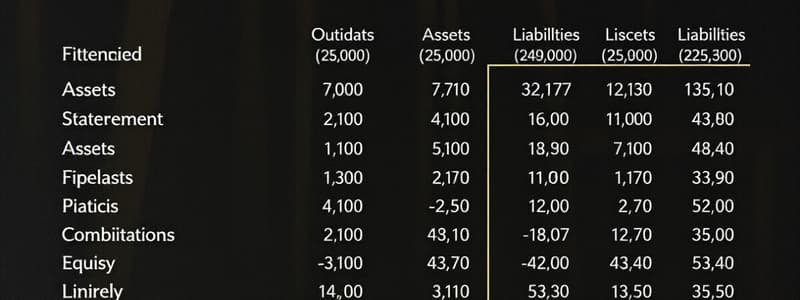Podcast
Questions and Answers
What is the primary purpose of the Statement of Financial Position?
What is the primary purpose of the Statement of Financial Position?
- To estimate future revenues
- To prepare cash flow statements
- To assess the financial health of an organization (correct)
- To track non-financial performance metrics
Which of the following best describes current assets?
Which of the following best describes current assets?
- Assets that are used beyond one year
- Assets not owned by the entity
- Long-term investments
- Resources expected to be converted into cash within one year (correct)
What are non-current liabilities?
What are non-current liabilities?
- Obligations that are due within one year
- Short-term debts
- Obligations that are due beyond one year (correct)
- Accounts payable
Which equation represents the relationship in the Statement of Financial Position?
Which equation represents the relationship in the Statement of Financial Position?
What section typically appears on the left side of the Statement of Financial Position?
What section typically appears on the left side of the Statement of Financial Position?
Which component is included in equity?
Which component is included in equity?
What should the Statement of Financial Position comply with?
What should the Statement of Financial Position comply with?
How often is the Statement of Financial Position typically prepared?
How often is the Statement of Financial Position typically prepared?
Which type of assets would include property and equipment?
Which type of assets would include property and equipment?
What does the Statement of Financial Position help stakeholders evaluate?
What does the Statement of Financial Position help stakeholders evaluate?
Flashcards are hidden until you start studying
Study Notes
Statement of Financial Position
-
Definition: A financial document that provides a snapshot of an entity's assets, liabilities, and equity at a specific point in time.
-
Purpose:
- To assess the financial health of an organization.
- To understand the liquidity and solvency of the entity.
- To facilitate decision-making for stakeholders.
-
Components:
-
Assets: Resources owned by the entity.
- Current Assets: Expected to be converted into cash or used within one year (e.g., cash, accounts receivable, inventory).
- Non-Current Assets: Long-term investments that will provide benefits beyond one year (e.g., property, plant, equipment, intangible assets).
-
Liabilities: Obligations owed by the entity.
- Current Liabilities: Due within one year (e.g., accounts payable, short-term debt).
- Non-Current Liabilities: Due beyond one year (e.g., long-term debt, deferred tax liabilities).
-
Equity: The residual interest in the assets after deducting liabilities.
- Components include common stock, retained earnings, and additional paid-in capital.
-
-
Equation:
- The fundamental equation governing the Statement of Financial Position is:
- Assets = Liabilities + Equity
- The fundamental equation governing the Statement of Financial Position is:
-
Format:
- Typically structured in two sections (sometimes presented vertically or horizontally):
- Left side for assets.
- Right side for liabilities and equity.
- Typically structured in two sections (sometimes presented vertically or horizontally):
-
Importance:
- Provides stakeholders (investors, creditors, management) with key insights into the company's financial stability.
- Assists in evaluating performance over time through comparative analysis with previous periods or industry benchmarks.
-
Reporting Standards:
- Must comply with accounting frameworks (e.g., IFRS, GAAP).
- Requires accurate classification and measurement of assets and liabilities.
-
Frequency:
- Often prepared annually, but may also be prepared quarterly or monthly for internal management purposes.
Statement of Financial Position
- A financial document that presents an entity's assets, liabilities, and equity at a specific date.
- Aims to evaluate an organization's financial health and aids stakeholders in decision-making regarding liquidity and solvency.
Components
-
Assets: Resources owned by the entity categorized into:
- Current Assets: Expected to be converted into cash or utilized within one year (e.g., cash, accounts receivable, inventory).
- Non-Current Assets: Long-term investments providing value beyond one year (e.g., property, plant, equipment, intangible assets).
-
Liabilities: Obligations that the entity owes, divided into:
- Current Liabilities: Obligations due within one year (e.g., accounts payable, short-term debt).
- Non-Current Liabilities: Obligations due beyond one year (e.g., long-term debt, deferred tax liabilities).
-
Equity: The owners' residual interest in the assets after subtracting liabilities, consisting of:
- Common stock, retained earnings, and additional paid-in capital.
Fundamental Equation
- Governed by the equation:
- Assets = Liabilities + Equity
Format
- Typically structured in two sections:
- Assets on the left side and liabilities plus equity on the right side, which may be presented either vertically or horizontally.
Importance
- Provides stakeholders, such as investors, creditors, and management, with insights into the company's financial stability.
- Facilitates performance evaluation over time by enabling comparative analysis with previous periods or industry benchmarks.
Reporting Standards
- Must adhere to accounting frameworks like IFRS or GAAP.
- Requires accurate classification and measurement of assets and liabilities to ensure reliability.
Frequency
- Often prepared annually, but can also be compiled quarterly or monthly for internal management uses.
Studying That Suits You
Use AI to generate personalized quizzes and flashcards to suit your learning preferences.




